Road Accidents in Saudi Arabia: Causes, Impacts, and Solutions
VerifiedAdded on 2022/12/27
|21
|5886
|99
Report
AI Summary
This report provides a comprehensive investigation into road traffic accidents in Saudi Arabia, examining the rationale behind the study, which highlights the significant impact of road accidents on the country's economy and public health. The research explores the causes of accidents, including reckless driving, lack of adherence to traffic regulations, and the impact of environmental factors such as high temperatures. The report reviews existing literature and data, including statistics on fatalities and economic costs, to provide a detailed analysis of the problem. The study aims to determine the causes of vehicular accidents, investigate their economic impact on Saudi Arabia and families, and propose strategies for improving road safety. The report includes a literature review, research questions, methodology, and ethical considerations, culminating in conclusions and recommendations aimed at reducing road traffic accidents and their consequences. The financial burden on the country, the loss of lives, and the social and economic impacts on families are key concerns addressed in this research.
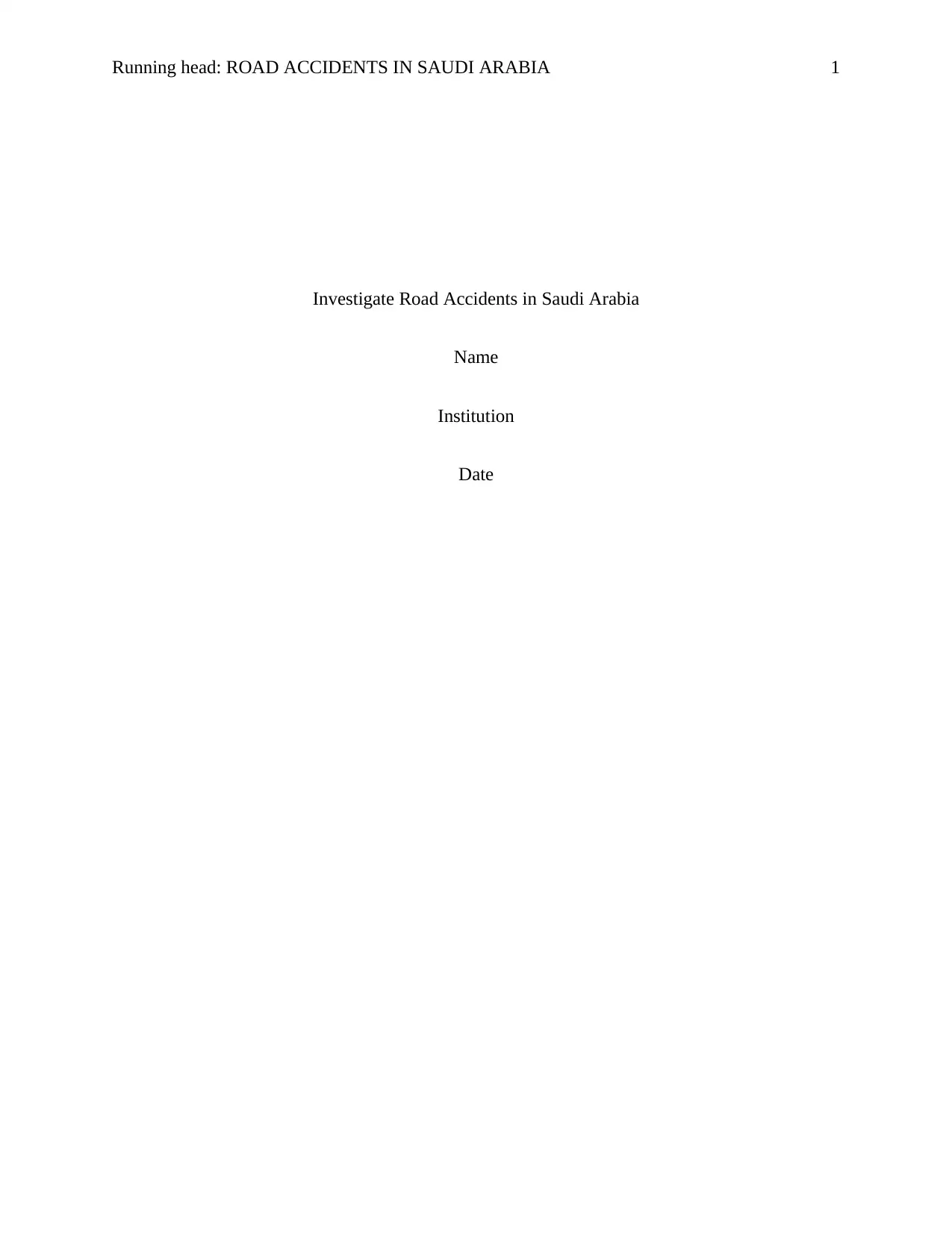
Running head: ROAD ACCIDENTS IN SAUDI ARABIA 1
Investigate Road Accidents in Saudi Arabia
Name
Institution
Date
Investigate Road Accidents in Saudi Arabia
Name
Institution
Date
Paraphrase This Document
Need a fresh take? Get an instant paraphrase of this document with our AI Paraphraser
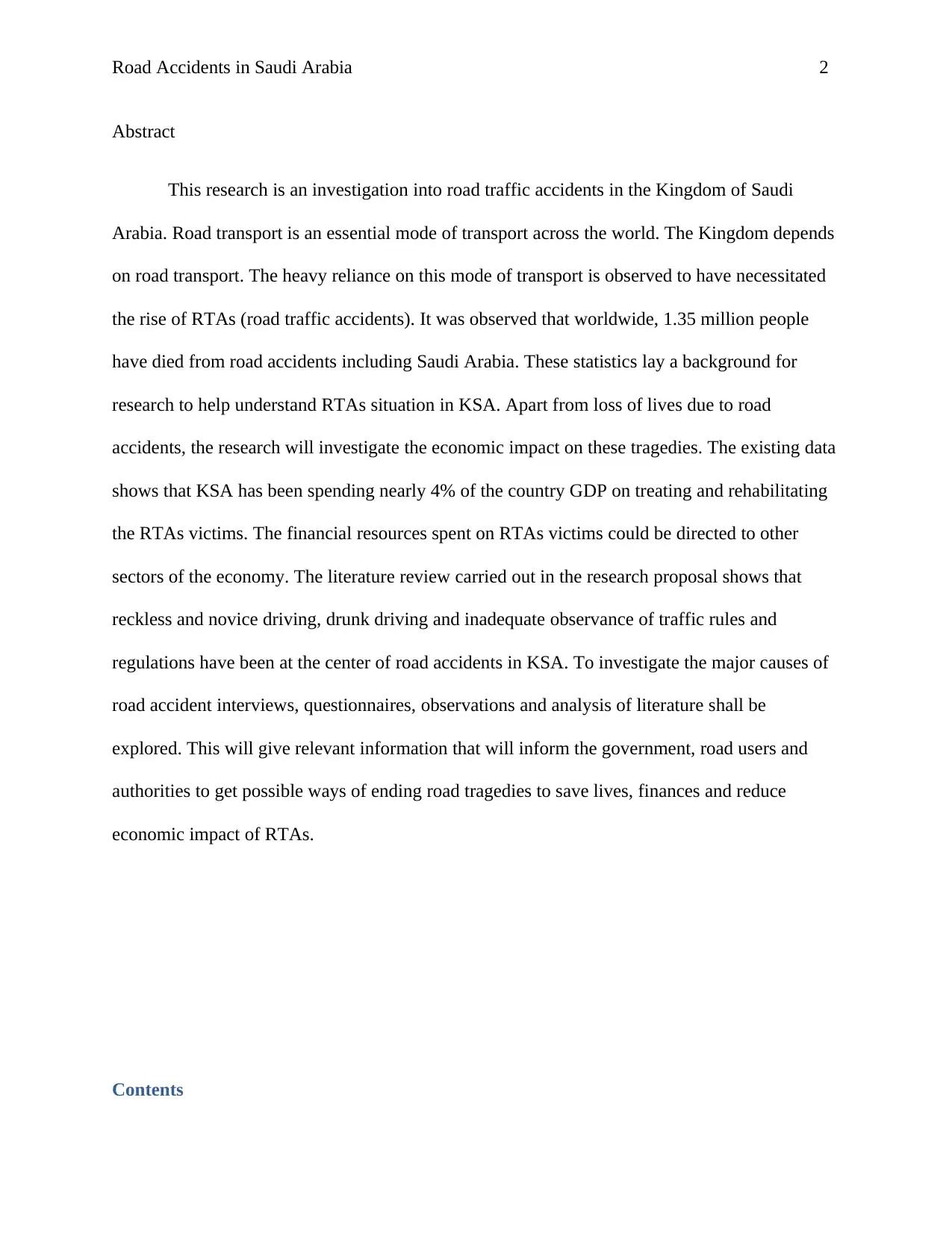
Road Accidents in Saudi Arabia 2
Abstract
This research is an investigation into road traffic accidents in the Kingdom of Saudi
Arabia. Road transport is an essential mode of transport across the world. The Kingdom depends
on road transport. The heavy reliance on this mode of transport is observed to have necessitated
the rise of RTAs (road traffic accidents). It was observed that worldwide, 1.35 million people
have died from road accidents including Saudi Arabia. These statistics lay a background for
research to help understand RTAs situation in KSA. Apart from loss of lives due to road
accidents, the research will investigate the economic impact on these tragedies. The existing data
shows that KSA has been spending nearly 4% of the country GDP on treating and rehabilitating
the RTAs victims. The financial resources spent on RTAs victims could be directed to other
sectors of the economy. The literature review carried out in the research proposal shows that
reckless and novice driving, drunk driving and inadequate observance of traffic rules and
regulations have been at the center of road accidents in KSA. To investigate the major causes of
road accident interviews, questionnaires, observations and analysis of literature shall be
explored. This will give relevant information that will inform the government, road users and
authorities to get possible ways of ending road tragedies to save lives, finances and reduce
economic impact of RTAs.
Contents
Abstract
This research is an investigation into road traffic accidents in the Kingdom of Saudi
Arabia. Road transport is an essential mode of transport across the world. The Kingdom depends
on road transport. The heavy reliance on this mode of transport is observed to have necessitated
the rise of RTAs (road traffic accidents). It was observed that worldwide, 1.35 million people
have died from road accidents including Saudi Arabia. These statistics lay a background for
research to help understand RTAs situation in KSA. Apart from loss of lives due to road
accidents, the research will investigate the economic impact on these tragedies. The existing data
shows that KSA has been spending nearly 4% of the country GDP on treating and rehabilitating
the RTAs victims. The financial resources spent on RTAs victims could be directed to other
sectors of the economy. The literature review carried out in the research proposal shows that
reckless and novice driving, drunk driving and inadequate observance of traffic rules and
regulations have been at the center of road accidents in KSA. To investigate the major causes of
road accident interviews, questionnaires, observations and analysis of literature shall be
explored. This will give relevant information that will inform the government, road users and
authorities to get possible ways of ending road tragedies to save lives, finances and reduce
economic impact of RTAs.
Contents
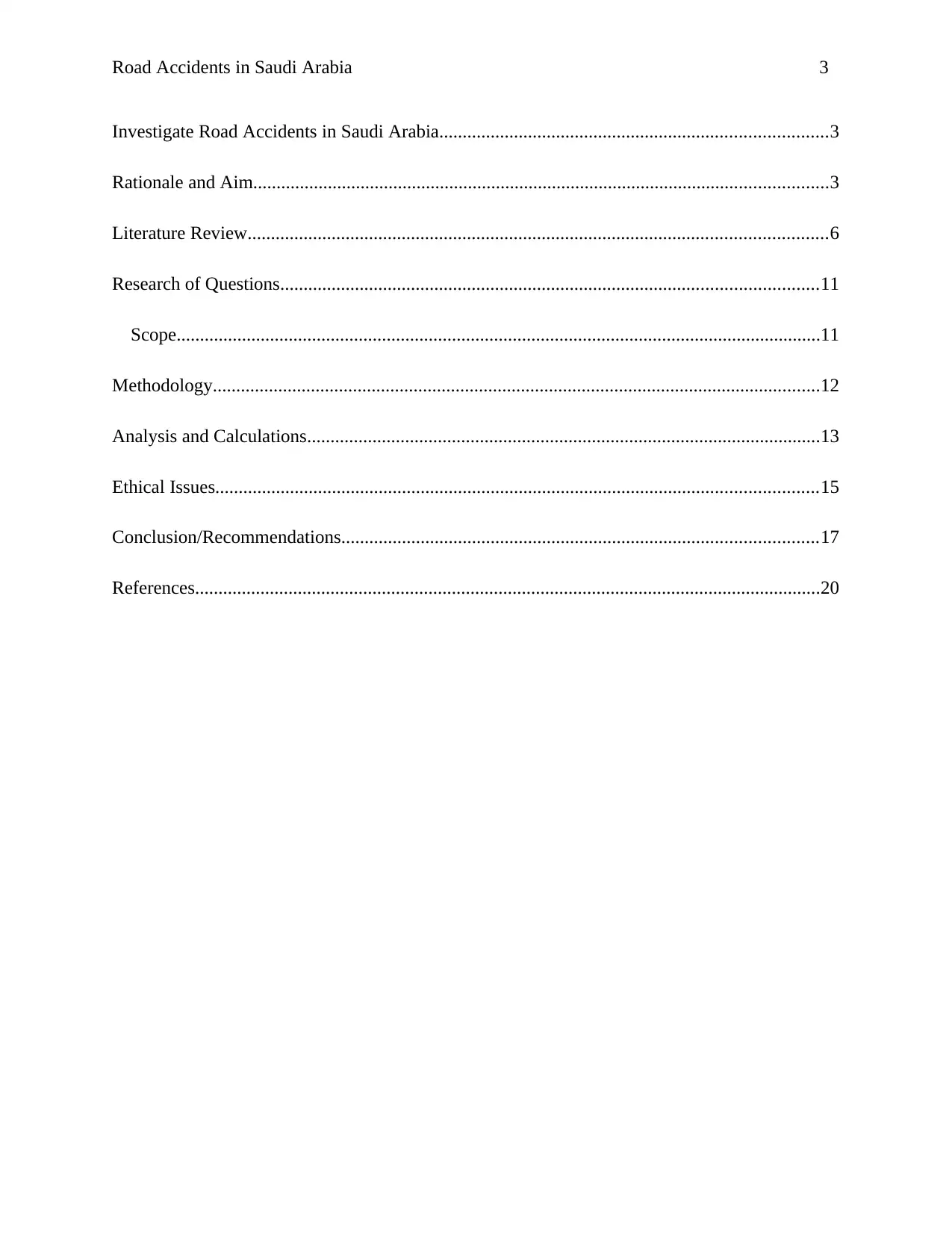
Road Accidents in Saudi Arabia 3
Investigate Road Accidents in Saudi Arabia...................................................................................3
Rationale and Aim...........................................................................................................................3
Literature Review............................................................................................................................6
Research of Questions...................................................................................................................11
Scope..........................................................................................................................................11
Methodology..................................................................................................................................12
Analysis and Calculations..............................................................................................................13
Ethical Issues.................................................................................................................................15
Conclusion/Recommendations......................................................................................................17
References......................................................................................................................................20
Investigate Road Accidents in Saudi Arabia...................................................................................3
Rationale and Aim...........................................................................................................................3
Literature Review............................................................................................................................6
Research of Questions...................................................................................................................11
Scope..........................................................................................................................................11
Methodology..................................................................................................................................12
Analysis and Calculations..............................................................................................................13
Ethical Issues.................................................................................................................................15
Conclusion/Recommendations......................................................................................................17
References......................................................................................................................................20
⊘ This is a preview!⊘
Do you want full access?
Subscribe today to unlock all pages.

Trusted by 1+ million students worldwide
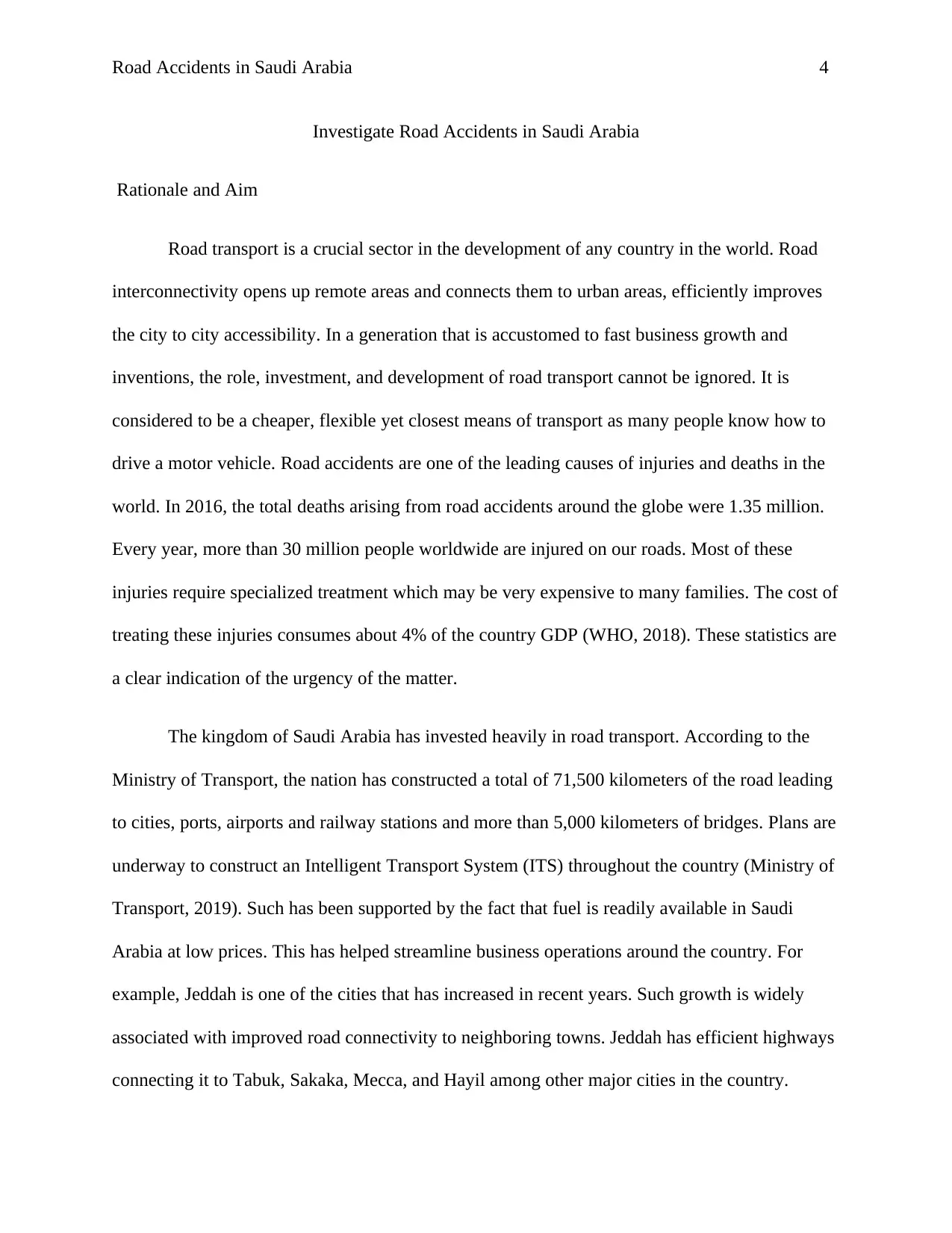
Road Accidents in Saudi Arabia 4
Investigate Road Accidents in Saudi Arabia
Rationale and Aim
Road transport is a crucial sector in the development of any country in the world. Road
interconnectivity opens up remote areas and connects them to urban areas, efficiently improves
the city to city accessibility. In a generation that is accustomed to fast business growth and
inventions, the role, investment, and development of road transport cannot be ignored. It is
considered to be a cheaper, flexible yet closest means of transport as many people know how to
drive a motor vehicle. Road accidents are one of the leading causes of injuries and deaths in the
world. In 2016, the total deaths arising from road accidents around the globe were 1.35 million.
Every year, more than 30 million people worldwide are injured on our roads. Most of these
injuries require specialized treatment which may be very expensive to many families. The cost of
treating these injuries consumes about 4% of the country GDP (WHO, 2018). These statistics are
a clear indication of the urgency of the matter.
The kingdom of Saudi Arabia has invested heavily in road transport. According to the
Ministry of Transport, the nation has constructed a total of 71,500 kilometers of the road leading
to cities, ports, airports and railway stations and more than 5,000 kilometers of bridges. Plans are
underway to construct an Intelligent Transport System (ITS) throughout the country (Ministry of
Transport, 2019). Such has been supported by the fact that fuel is readily available in Saudi
Arabia at low prices. This has helped streamline business operations around the country. For
example, Jeddah is one of the cities that has increased in recent years. Such growth is widely
associated with improved road connectivity to neighboring towns. Jeddah has efficient highways
connecting it to Tabuk, Sakaka, Mecca, and Hayil among other major cities in the country.
Investigate Road Accidents in Saudi Arabia
Rationale and Aim
Road transport is a crucial sector in the development of any country in the world. Road
interconnectivity opens up remote areas and connects them to urban areas, efficiently improves
the city to city accessibility. In a generation that is accustomed to fast business growth and
inventions, the role, investment, and development of road transport cannot be ignored. It is
considered to be a cheaper, flexible yet closest means of transport as many people know how to
drive a motor vehicle. Road accidents are one of the leading causes of injuries and deaths in the
world. In 2016, the total deaths arising from road accidents around the globe were 1.35 million.
Every year, more than 30 million people worldwide are injured on our roads. Most of these
injuries require specialized treatment which may be very expensive to many families. The cost of
treating these injuries consumes about 4% of the country GDP (WHO, 2018). These statistics are
a clear indication of the urgency of the matter.
The kingdom of Saudi Arabia has invested heavily in road transport. According to the
Ministry of Transport, the nation has constructed a total of 71,500 kilometers of the road leading
to cities, ports, airports and railway stations and more than 5,000 kilometers of bridges. Plans are
underway to construct an Intelligent Transport System (ITS) throughout the country (Ministry of
Transport, 2019). Such has been supported by the fact that fuel is readily available in Saudi
Arabia at low prices. This has helped streamline business operations around the country. For
example, Jeddah is one of the cities that has increased in recent years. Such growth is widely
associated with improved road connectivity to neighboring towns. Jeddah has efficient highways
connecting it to Tabuk, Sakaka, Mecca, and Hayil among other major cities in the country.
Paraphrase This Document
Need a fresh take? Get an instant paraphrase of this document with our AI Paraphraser
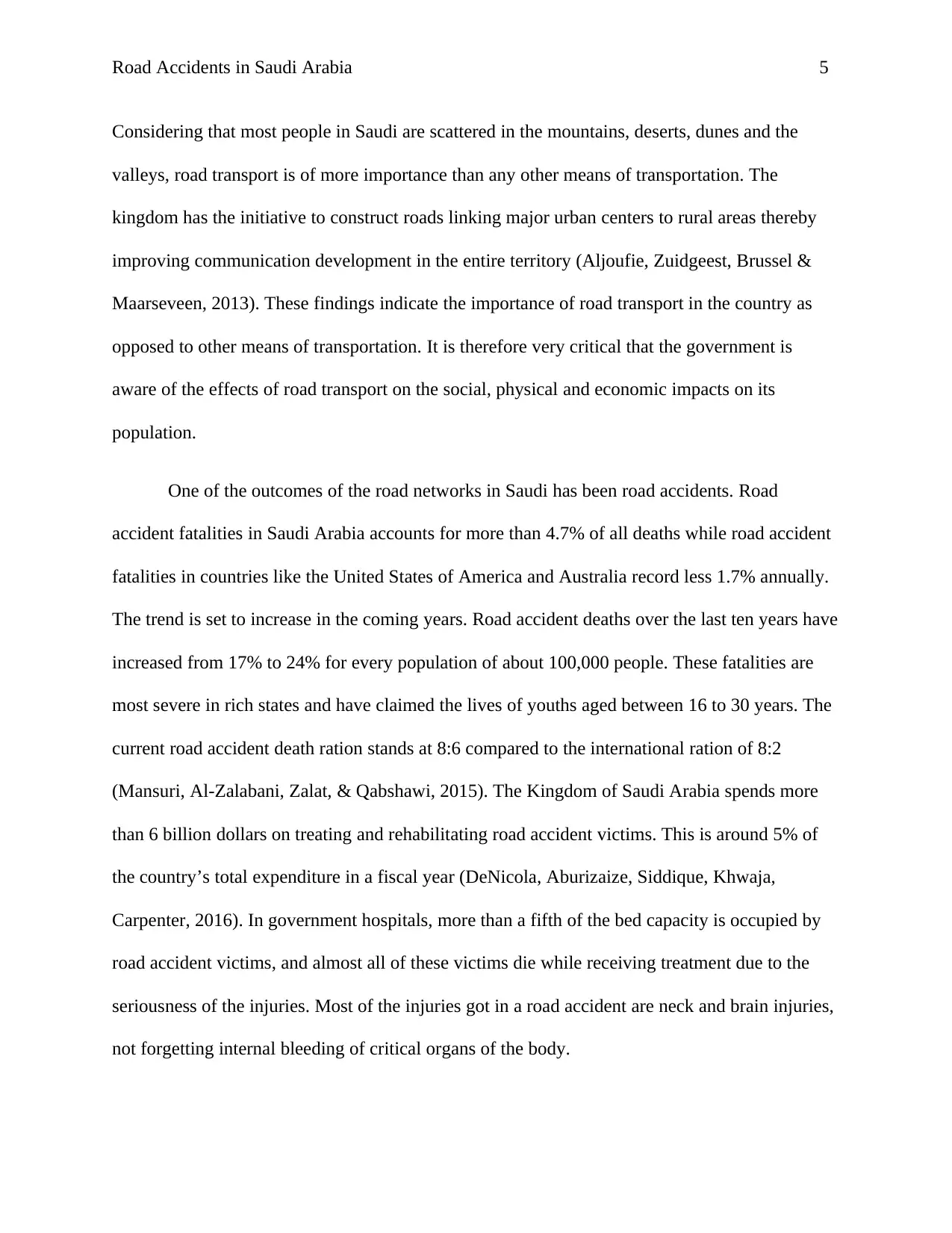
Road Accidents in Saudi Arabia 5
Considering that most people in Saudi are scattered in the mountains, deserts, dunes and the
valleys, road transport is of more importance than any other means of transportation. The
kingdom has the initiative to construct roads linking major urban centers to rural areas thereby
improving communication development in the entire territory (Aljoufie, Zuidgeest, Brussel &
Maarseveen, 2013). These findings indicate the importance of road transport in the country as
opposed to other means of transportation. It is therefore very critical that the government is
aware of the effects of road transport on the social, physical and economic impacts on its
population.
One of the outcomes of the road networks in Saudi has been road accidents. Road
accident fatalities in Saudi Arabia accounts for more than 4.7% of all deaths while road accident
fatalities in countries like the United States of America and Australia record less 1.7% annually.
The trend is set to increase in the coming years. Road accident deaths over the last ten years have
increased from 17% to 24% for every population of about 100,000 people. These fatalities are
most severe in rich states and have claimed the lives of youths aged between 16 to 30 years. The
current road accident death ration stands at 8:6 compared to the international ration of 8:2
(Mansuri, Al-Zalabani, Zalat, & Qabshawi, 2015). The Kingdom of Saudi Arabia spends more
than 6 billion dollars on treating and rehabilitating road accident victims. This is around 5% of
the country’s total expenditure in a fiscal year (DeNicola, Aburizaize, Siddique, Khwaja,
Carpenter, 2016). In government hospitals, more than a fifth of the bed capacity is occupied by
road accident victims, and almost all of these victims die while receiving treatment due to the
seriousness of the injuries. Most of the injuries got in a road accident are neck and brain injuries,
not forgetting internal bleeding of critical organs of the body.
Considering that most people in Saudi are scattered in the mountains, deserts, dunes and the
valleys, road transport is of more importance than any other means of transportation. The
kingdom has the initiative to construct roads linking major urban centers to rural areas thereby
improving communication development in the entire territory (Aljoufie, Zuidgeest, Brussel &
Maarseveen, 2013). These findings indicate the importance of road transport in the country as
opposed to other means of transportation. It is therefore very critical that the government is
aware of the effects of road transport on the social, physical and economic impacts on its
population.
One of the outcomes of the road networks in Saudi has been road accidents. Road
accident fatalities in Saudi Arabia accounts for more than 4.7% of all deaths while road accident
fatalities in countries like the United States of America and Australia record less 1.7% annually.
The trend is set to increase in the coming years. Road accident deaths over the last ten years have
increased from 17% to 24% for every population of about 100,000 people. These fatalities are
most severe in rich states and have claimed the lives of youths aged between 16 to 30 years. The
current road accident death ration stands at 8:6 compared to the international ration of 8:2
(Mansuri, Al-Zalabani, Zalat, & Qabshawi, 2015). The Kingdom of Saudi Arabia spends more
than 6 billion dollars on treating and rehabilitating road accident victims. This is around 5% of
the country’s total expenditure in a fiscal year (DeNicola, Aburizaize, Siddique, Khwaja,
Carpenter, 2016). In government hospitals, more than a fifth of the bed capacity is occupied by
road accident victims, and almost all of these victims die while receiving treatment due to the
seriousness of the injuries. Most of the injuries got in a road accident are neck and brain injuries,
not forgetting internal bleeding of critical organs of the body.

Road Accidents in Saudi Arabia 6
One of the reasons to study this to undertake this study is because of the increasing
financial burden left to the country and family of the victim. Families have to spend vast
amounts of money on the treatment of their loved ones. Considering that most of the accident
victims in Saudi Arabia are youths less than 35 years who were probably the breadwinners in the
family, these families are left financially stricken with no one to provide for them. Not only is
this impact felt at the family level, but also at the national level. These young people play a vital
role in the growth of the country’s economy. On the other hand, the government has to spend
vast amounts of money on providing healthcare infrastructure for accident victims, for example,
in improving emergency services of road victims and constructing special wards for them.
In addition to that, the loss of a person is a societal loss. It causes unwanted grief and
trauma among the people, and the ripple effects are sometimes catastrophic. For example, it
could lead to clinical depression upon family members and friends of the deceased. To the
extreme, it is occasionally suicidal. According to DeNicola et al. (2016), 0.09% of road accidents
in Saudi Arabia are caused by drug and substance abuse. There is a possibility that this is a ripple
effect of previous accidents which led to substance abuse of the bereaved hence more accidents.
The ever-rising road accidents in this country raise the debate of the government’s
contribution to these deaths. It is unexpected that a country with such fascinating roads and low
fuel prices would record one of the most road traffic accidents. This raises the question of
whether the roads are well designed. The curriculum by the Ministry of Transportation to train
drivers is also questionable. Complacency in the implementation of traffic laws by country’s
traffic and safety authority is viable. On the other side, cultural issues in Saudi Arabia like drink
driving, use of electronic gadgets while driving and over speeding contribute to this menace.
One of the reasons to study this to undertake this study is because of the increasing
financial burden left to the country and family of the victim. Families have to spend vast
amounts of money on the treatment of their loved ones. Considering that most of the accident
victims in Saudi Arabia are youths less than 35 years who were probably the breadwinners in the
family, these families are left financially stricken with no one to provide for them. Not only is
this impact felt at the family level, but also at the national level. These young people play a vital
role in the growth of the country’s economy. On the other hand, the government has to spend
vast amounts of money on providing healthcare infrastructure for accident victims, for example,
in improving emergency services of road victims and constructing special wards for them.
In addition to that, the loss of a person is a societal loss. It causes unwanted grief and
trauma among the people, and the ripple effects are sometimes catastrophic. For example, it
could lead to clinical depression upon family members and friends of the deceased. To the
extreme, it is occasionally suicidal. According to DeNicola et al. (2016), 0.09% of road accidents
in Saudi Arabia are caused by drug and substance abuse. There is a possibility that this is a ripple
effect of previous accidents which led to substance abuse of the bereaved hence more accidents.
The ever-rising road accidents in this country raise the debate of the government’s
contribution to these deaths. It is unexpected that a country with such fascinating roads and low
fuel prices would record one of the most road traffic accidents. This raises the question of
whether the roads are well designed. The curriculum by the Ministry of Transportation to train
drivers is also questionable. Complacency in the implementation of traffic laws by country’s
traffic and safety authority is viable. On the other side, cultural issues in Saudi Arabia like drink
driving, use of electronic gadgets while driving and over speeding contribute to this menace.
⊘ This is a preview!⊘
Do you want full access?
Subscribe today to unlock all pages.

Trusted by 1+ million students worldwide
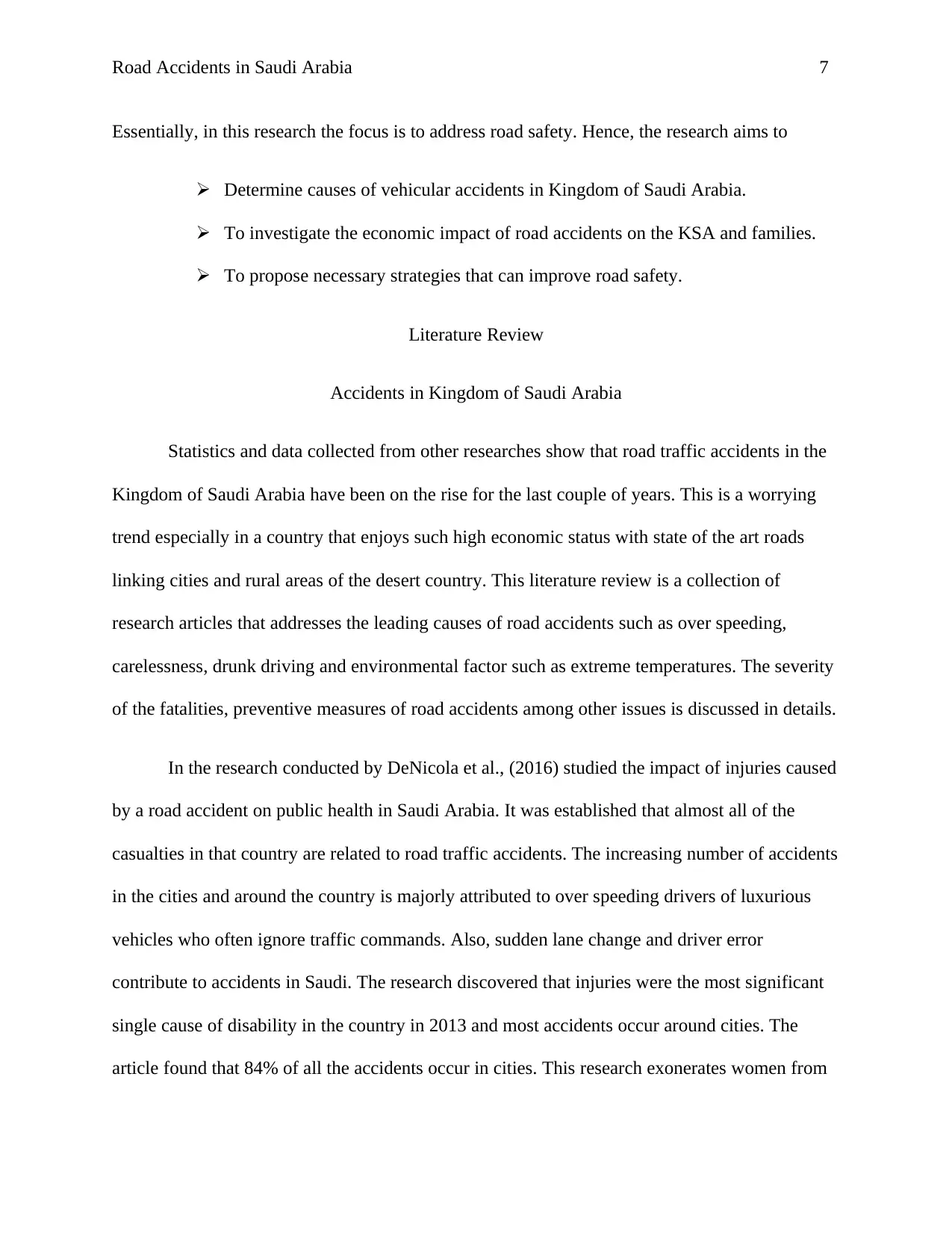
Road Accidents in Saudi Arabia 7
Essentially, in this research the focus is to address road safety. Hence, the research aims to
Determine causes of vehicular accidents in Kingdom of Saudi Arabia.
To investigate the economic impact of road accidents on the KSA and families.
To propose necessary strategies that can improve road safety.
Literature Review
Accidents in Kingdom of Saudi Arabia
Statistics and data collected from other researches show that road traffic accidents in the
Kingdom of Saudi Arabia have been on the rise for the last couple of years. This is a worrying
trend especially in a country that enjoys such high economic status with state of the art roads
linking cities and rural areas of the desert country. This literature review is a collection of
research articles that addresses the leading causes of road accidents such as over speeding,
carelessness, drunk driving and environmental factor such as extreme temperatures. The severity
of the fatalities, preventive measures of road accidents among other issues is discussed in details.
In the research conducted by DeNicola et al., (2016) studied the impact of injuries caused
by a road accident on public health in Saudi Arabia. It was established that almost all of the
casualties in that country are related to road traffic accidents. The increasing number of accidents
in the cities and around the country is majorly attributed to over speeding drivers of luxurious
vehicles who often ignore traffic commands. Also, sudden lane change and driver error
contribute to accidents in Saudi. The research discovered that injuries were the most significant
single cause of disability in the country in 2013 and most accidents occur around cities. The
article found that 84% of all the accidents occur in cities. This research exonerates women from
Essentially, in this research the focus is to address road safety. Hence, the research aims to
Determine causes of vehicular accidents in Kingdom of Saudi Arabia.
To investigate the economic impact of road accidents on the KSA and families.
To propose necessary strategies that can improve road safety.
Literature Review
Accidents in Kingdom of Saudi Arabia
Statistics and data collected from other researches show that road traffic accidents in the
Kingdom of Saudi Arabia have been on the rise for the last couple of years. This is a worrying
trend especially in a country that enjoys such high economic status with state of the art roads
linking cities and rural areas of the desert country. This literature review is a collection of
research articles that addresses the leading causes of road accidents such as over speeding,
carelessness, drunk driving and environmental factor such as extreme temperatures. The severity
of the fatalities, preventive measures of road accidents among other issues is discussed in details.
In the research conducted by DeNicola et al., (2016) studied the impact of injuries caused
by a road accident on public health in Saudi Arabia. It was established that almost all of the
casualties in that country are related to road traffic accidents. The increasing number of accidents
in the cities and around the country is majorly attributed to over speeding drivers of luxurious
vehicles who often ignore traffic commands. Also, sudden lane change and driver error
contribute to accidents in Saudi. The research discovered that injuries were the most significant
single cause of disability in the country in 2013 and most accidents occur around cities. The
article found that 84% of all the accidents occur in cities. This research exonerates women from
Paraphrase This Document
Need a fresh take? Get an instant paraphrase of this document with our AI Paraphraser
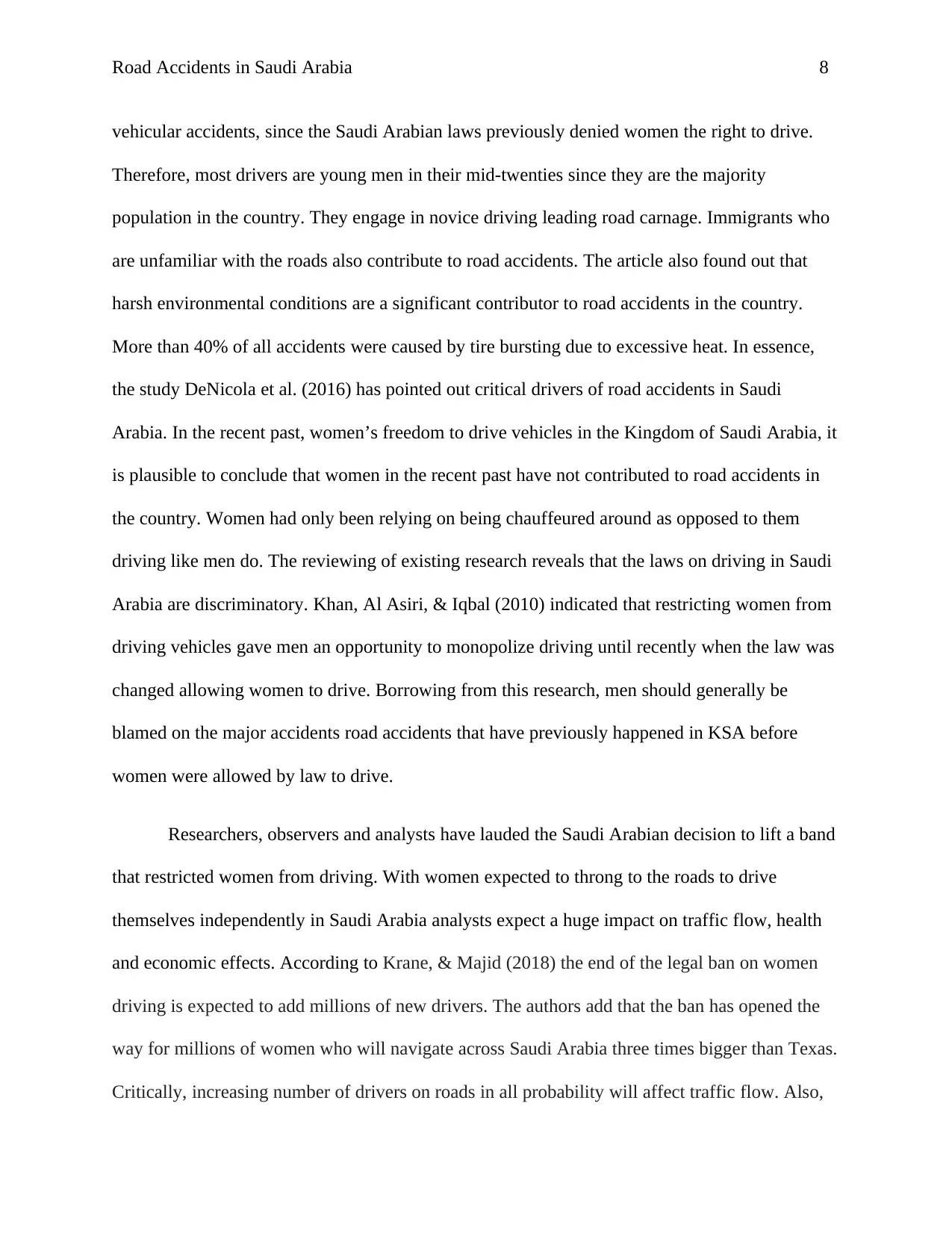
Road Accidents in Saudi Arabia 8
vehicular accidents, since the Saudi Arabian laws previously denied women the right to drive.
Therefore, most drivers are young men in their mid-twenties since they are the majority
population in the country. They engage in novice driving leading road carnage. Immigrants who
are unfamiliar with the roads also contribute to road accidents. The article also found out that
harsh environmental conditions are a significant contributor to road accidents in the country.
More than 40% of all accidents were caused by tire bursting due to excessive heat. In essence,
the study DeNicola et al. (2016) has pointed out critical drivers of road accidents in Saudi
Arabia. In the recent past, women’s freedom to drive vehicles in the Kingdom of Saudi Arabia, it
is plausible to conclude that women in the recent past have not contributed to road accidents in
the country. Women had only been relying on being chauffeured around as opposed to them
driving like men do. The reviewing of existing research reveals that the laws on driving in Saudi
Arabia are discriminatory. Khan, Al Asiri, & Iqbal (2010) indicated that restricting women from
driving vehicles gave men an opportunity to monopolize driving until recently when the law was
changed allowing women to drive. Borrowing from this research, men should generally be
blamed on the major accidents road accidents that have previously happened in KSA before
women were allowed by law to drive.
Researchers, observers and analysts have lauded the Saudi Arabian decision to lift a band
that restricted women from driving. With women expected to throng to the roads to drive
themselves independently in Saudi Arabia analysts expect a huge impact on traffic flow, health
and economic effects. According to Krane, & Majid (2018) the end of the legal ban on women
driving is expected to add millions of new drivers. The authors add that the ban has opened the
way for millions of women who will navigate across Saudi Arabia three times bigger than Texas.
Critically, increasing number of drivers on roads in all probability will affect traffic flow. Also,
vehicular accidents, since the Saudi Arabian laws previously denied women the right to drive.
Therefore, most drivers are young men in their mid-twenties since they are the majority
population in the country. They engage in novice driving leading road carnage. Immigrants who
are unfamiliar with the roads also contribute to road accidents. The article also found out that
harsh environmental conditions are a significant contributor to road accidents in the country.
More than 40% of all accidents were caused by tire bursting due to excessive heat. In essence,
the study DeNicola et al. (2016) has pointed out critical drivers of road accidents in Saudi
Arabia. In the recent past, women’s freedom to drive vehicles in the Kingdom of Saudi Arabia, it
is plausible to conclude that women in the recent past have not contributed to road accidents in
the country. Women had only been relying on being chauffeured around as opposed to them
driving like men do. The reviewing of existing research reveals that the laws on driving in Saudi
Arabia are discriminatory. Khan, Al Asiri, & Iqbal (2010) indicated that restricting women from
driving vehicles gave men an opportunity to monopolize driving until recently when the law was
changed allowing women to drive. Borrowing from this research, men should generally be
blamed on the major accidents road accidents that have previously happened in KSA before
women were allowed by law to drive.
Researchers, observers and analysts have lauded the Saudi Arabian decision to lift a band
that restricted women from driving. With women expected to throng to the roads to drive
themselves independently in Saudi Arabia analysts expect a huge impact on traffic flow, health
and economic effects. According to Krane, & Majid (2018) the end of the legal ban on women
driving is expected to add millions of new drivers. The authors add that the ban has opened the
way for millions of women who will navigate across Saudi Arabia three times bigger than Texas.
Critically, increasing number of drivers on roads in all probability will affect traffic flow. Also,
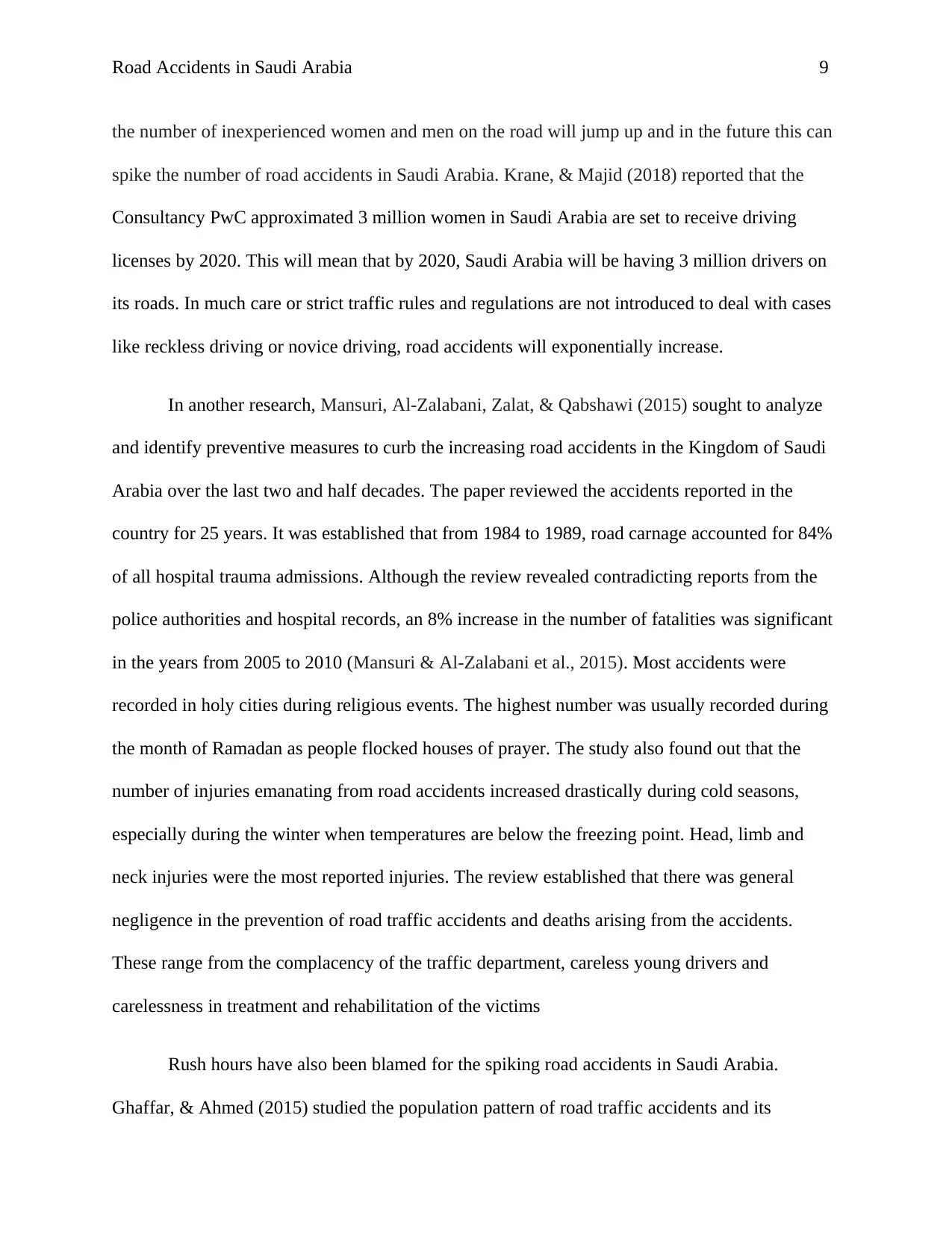
Road Accidents in Saudi Arabia 9
the number of inexperienced women and men on the road will jump up and in the future this can
spike the number of road accidents in Saudi Arabia. Krane, & Majid (2018) reported that the
Consultancy PwC approximated 3 million women in Saudi Arabia are set to receive driving
licenses by 2020. This will mean that by 2020, Saudi Arabia will be having 3 million drivers on
its roads. In much care or strict traffic rules and regulations are not introduced to deal with cases
like reckless driving or novice driving, road accidents will exponentially increase.
In another research, Mansuri, Al-Zalabani, Zalat, & Qabshawi (2015) sought to analyze
and identify preventive measures to curb the increasing road accidents in the Kingdom of Saudi
Arabia over the last two and half decades. The paper reviewed the accidents reported in the
country for 25 years. It was established that from 1984 to 1989, road carnage accounted for 84%
of all hospital trauma admissions. Although the review revealed contradicting reports from the
police authorities and hospital records, an 8% increase in the number of fatalities was significant
in the years from 2005 to 2010 (Mansuri & Al-Zalabani et al., 2015). Most accidents were
recorded in holy cities during religious events. The highest number was usually recorded during
the month of Ramadan as people flocked houses of prayer. The study also found out that the
number of injuries emanating from road accidents increased drastically during cold seasons,
especially during the winter when temperatures are below the freezing point. Head, limb and
neck injuries were the most reported injuries. The review established that there was general
negligence in the prevention of road traffic accidents and deaths arising from the accidents.
These range from the complacency of the traffic department, careless young drivers and
carelessness in treatment and rehabilitation of the victims
Rush hours have also been blamed for the spiking road accidents in Saudi Arabia.
Ghaffar, & Ahmed (2015) studied the population pattern of road traffic accidents and its
the number of inexperienced women and men on the road will jump up and in the future this can
spike the number of road accidents in Saudi Arabia. Krane, & Majid (2018) reported that the
Consultancy PwC approximated 3 million women in Saudi Arabia are set to receive driving
licenses by 2020. This will mean that by 2020, Saudi Arabia will be having 3 million drivers on
its roads. In much care or strict traffic rules and regulations are not introduced to deal with cases
like reckless driving or novice driving, road accidents will exponentially increase.
In another research, Mansuri, Al-Zalabani, Zalat, & Qabshawi (2015) sought to analyze
and identify preventive measures to curb the increasing road accidents in the Kingdom of Saudi
Arabia over the last two and half decades. The paper reviewed the accidents reported in the
country for 25 years. It was established that from 1984 to 1989, road carnage accounted for 84%
of all hospital trauma admissions. Although the review revealed contradicting reports from the
police authorities and hospital records, an 8% increase in the number of fatalities was significant
in the years from 2005 to 2010 (Mansuri & Al-Zalabani et al., 2015). Most accidents were
recorded in holy cities during religious events. The highest number was usually recorded during
the month of Ramadan as people flocked houses of prayer. The study also found out that the
number of injuries emanating from road accidents increased drastically during cold seasons,
especially during the winter when temperatures are below the freezing point. Head, limb and
neck injuries were the most reported injuries. The review established that there was general
negligence in the prevention of road traffic accidents and deaths arising from the accidents.
These range from the complacency of the traffic department, careless young drivers and
carelessness in treatment and rehabilitation of the victims
Rush hours have also been blamed for the spiking road accidents in Saudi Arabia.
Ghaffar, & Ahmed (2015) studied the population pattern of road traffic accidents and its
⊘ This is a preview!⊘
Do you want full access?
Subscribe today to unlock all pages.

Trusted by 1+ million students worldwide
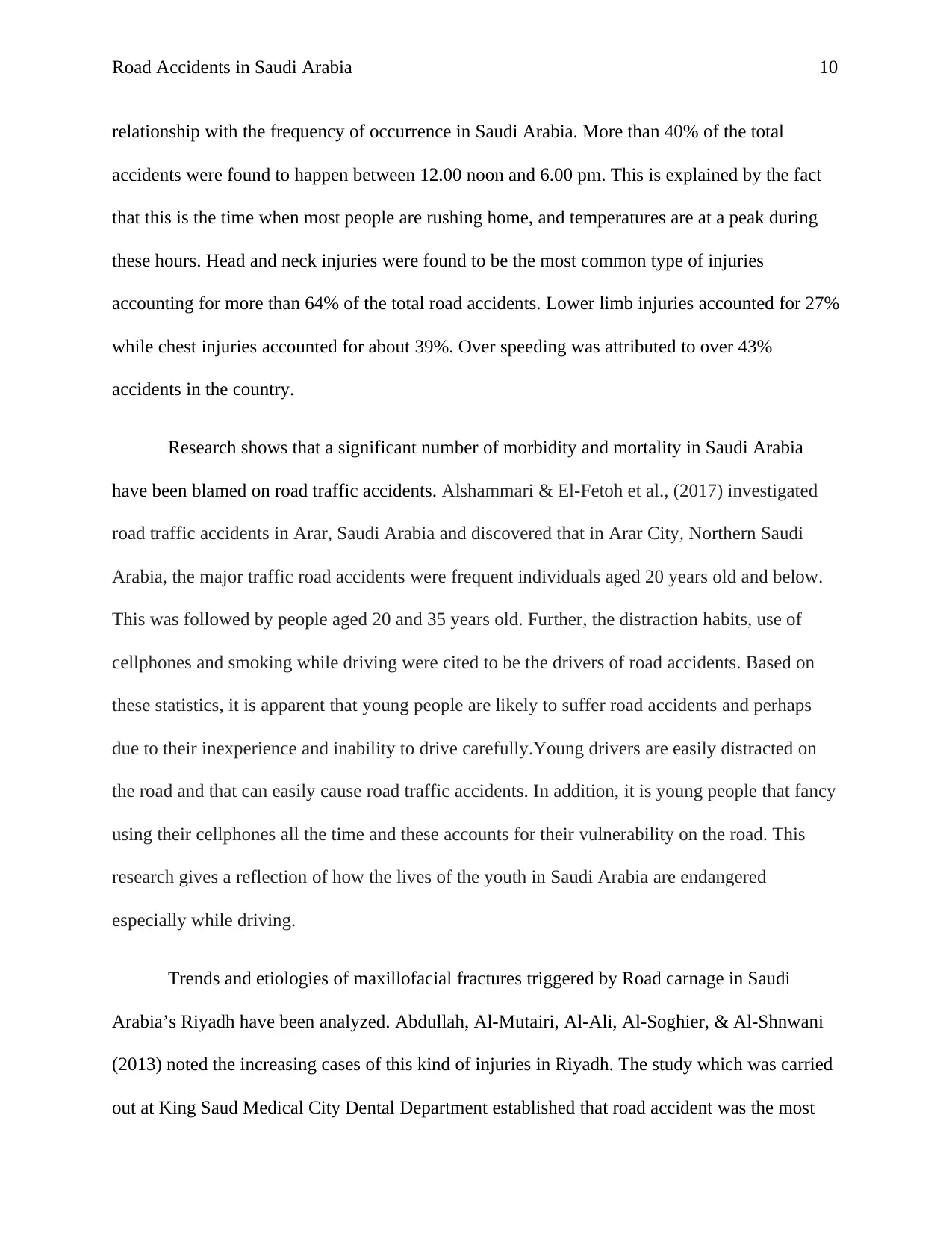
Road Accidents in Saudi Arabia 10
relationship with the frequency of occurrence in Saudi Arabia. More than 40% of the total
accidents were found to happen between 12.00 noon and 6.00 pm. This is explained by the fact
that this is the time when most people are rushing home, and temperatures are at a peak during
these hours. Head and neck injuries were found to be the most common type of injuries
accounting for more than 64% of the total road accidents. Lower limb injuries accounted for 27%
while chest injuries accounted for about 39%. Over speeding was attributed to over 43%
accidents in the country.
Research shows that a significant number of morbidity and mortality in Saudi Arabia
have been blamed on road traffic accidents. Alshammari & El-Fetoh et al., (2017) investigated
road traffic accidents in Arar, Saudi Arabia and discovered that in Arar City, Northern Saudi
Arabia, the major traffic road accidents were frequent individuals aged 20 years old and below.
This was followed by people aged 20 and 35 years old. Further, the distraction habits, use of
cellphones and smoking while driving were cited to be the drivers of road accidents. Based on
these statistics, it is apparent that young people are likely to suffer road accidents and perhaps
due to their inexperience and inability to drive carefully.Young drivers are easily distracted on
the road and that can easily cause road traffic accidents. In addition, it is young people that fancy
using their cellphones all the time and these accounts for their vulnerability on the road. This
research gives a reflection of how the lives of the youth in Saudi Arabia are endangered
especially while driving.
Trends and etiologies of maxillofacial fractures triggered by Road carnage in Saudi
Arabia’s Riyadh have been analyzed. Abdullah, Al-Mutairi, Al-Ali, Al-Soghier, & Al-Shnwani
(2013) noted the increasing cases of this kind of injuries in Riyadh. The study which was carried
out at King Saud Medical City Dental Department established that road accident was the most
relationship with the frequency of occurrence in Saudi Arabia. More than 40% of the total
accidents were found to happen between 12.00 noon and 6.00 pm. This is explained by the fact
that this is the time when most people are rushing home, and temperatures are at a peak during
these hours. Head and neck injuries were found to be the most common type of injuries
accounting for more than 64% of the total road accidents. Lower limb injuries accounted for 27%
while chest injuries accounted for about 39%. Over speeding was attributed to over 43%
accidents in the country.
Research shows that a significant number of morbidity and mortality in Saudi Arabia
have been blamed on road traffic accidents. Alshammari & El-Fetoh et al., (2017) investigated
road traffic accidents in Arar, Saudi Arabia and discovered that in Arar City, Northern Saudi
Arabia, the major traffic road accidents were frequent individuals aged 20 years old and below.
This was followed by people aged 20 and 35 years old. Further, the distraction habits, use of
cellphones and smoking while driving were cited to be the drivers of road accidents. Based on
these statistics, it is apparent that young people are likely to suffer road accidents and perhaps
due to their inexperience and inability to drive carefully.Young drivers are easily distracted on
the road and that can easily cause road traffic accidents. In addition, it is young people that fancy
using their cellphones all the time and these accounts for their vulnerability on the road. This
research gives a reflection of how the lives of the youth in Saudi Arabia are endangered
especially while driving.
Trends and etiologies of maxillofacial fractures triggered by Road carnage in Saudi
Arabia’s Riyadh have been analyzed. Abdullah, Al-Mutairi, Al-Ali, Al-Soghier, & Al-Shnwani
(2013) noted the increasing cases of this kind of injuries in Riyadh. The study which was carried
out at King Saud Medical City Dental Department established that road accident was the most
Paraphrase This Document
Need a fresh take? Get an instant paraphrase of this document with our AI Paraphraser
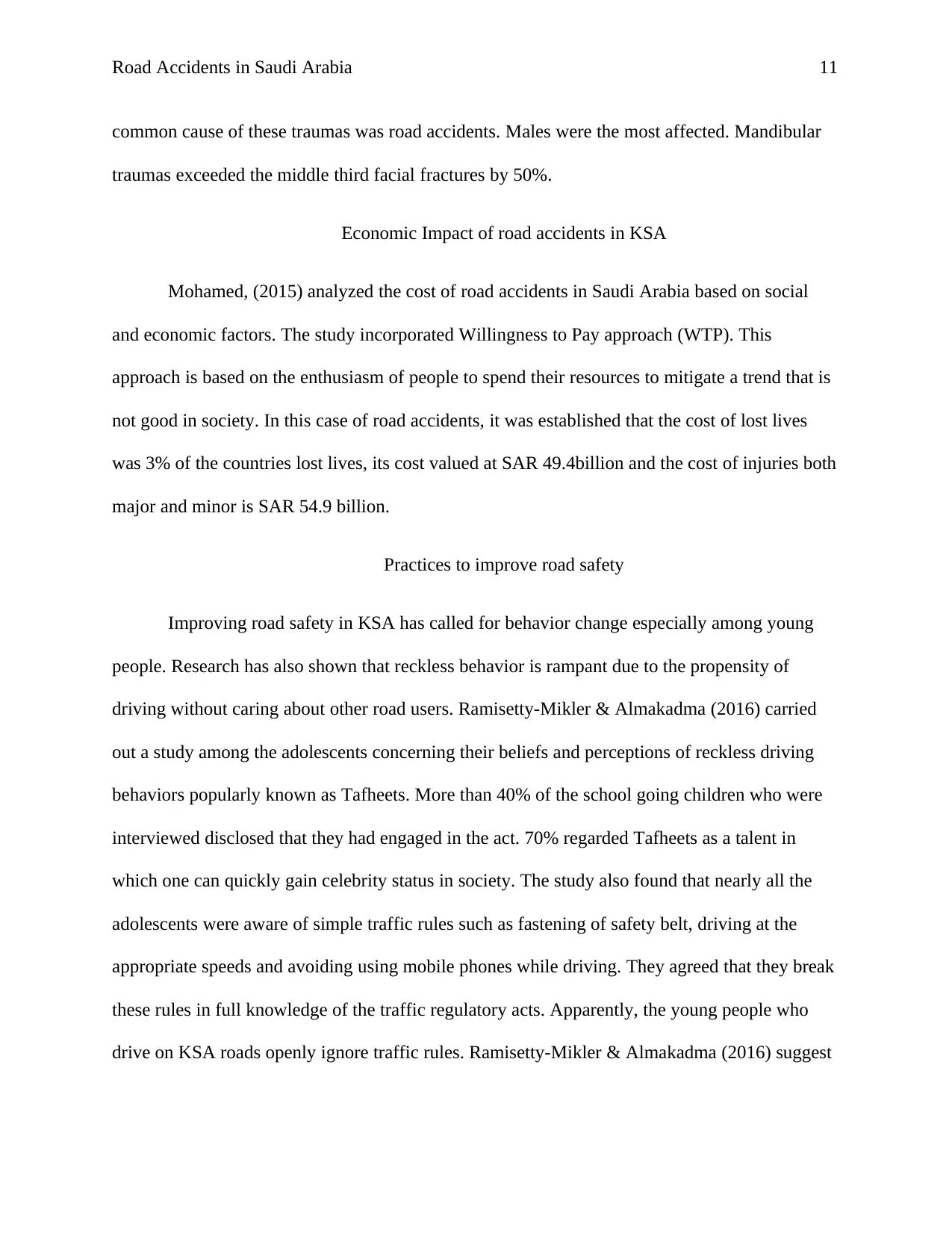
Road Accidents in Saudi Arabia 11
common cause of these traumas was road accidents. Males were the most affected. Mandibular
traumas exceeded the middle third facial fractures by 50%.
Economic Impact of road accidents in KSA
Mohamed, (2015) analyzed the cost of road accidents in Saudi Arabia based on social
and economic factors. The study incorporated Willingness to Pay approach (WTP). This
approach is based on the enthusiasm of people to spend their resources to mitigate a trend that is
not good in society. In this case of road accidents, it was established that the cost of lost lives
was 3% of the countries lost lives, its cost valued at SAR 49.4billion and the cost of injuries both
major and minor is SAR 54.9 billion.
Practices to improve road safety
Improving road safety in KSA has called for behavior change especially among young
people. Research has also shown that reckless behavior is rampant due to the propensity of
driving without caring about other road users. Ramisetty-Mikler & Almakadma (2016) carried
out a study among the adolescents concerning their beliefs and perceptions of reckless driving
behaviors popularly known as Tafheets. More than 40% of the school going children who were
interviewed disclosed that they had engaged in the act. 70% regarded Tafheets as a talent in
which one can quickly gain celebrity status in society. The study also found that nearly all the
adolescents were aware of simple traffic rules such as fastening of safety belt, driving at the
appropriate speeds and avoiding using mobile phones while driving. They agreed that they break
these rules in full knowledge of the traffic regulatory acts. Apparently, the young people who
drive on KSA roads openly ignore traffic rules. Ramisetty-Mikler & Almakadma (2016) suggest
common cause of these traumas was road accidents. Males were the most affected. Mandibular
traumas exceeded the middle third facial fractures by 50%.
Economic Impact of road accidents in KSA
Mohamed, (2015) analyzed the cost of road accidents in Saudi Arabia based on social
and economic factors. The study incorporated Willingness to Pay approach (WTP). This
approach is based on the enthusiasm of people to spend their resources to mitigate a trend that is
not good in society. In this case of road accidents, it was established that the cost of lost lives
was 3% of the countries lost lives, its cost valued at SAR 49.4billion and the cost of injuries both
major and minor is SAR 54.9 billion.
Practices to improve road safety
Improving road safety in KSA has called for behavior change especially among young
people. Research has also shown that reckless behavior is rampant due to the propensity of
driving without caring about other road users. Ramisetty-Mikler & Almakadma (2016) carried
out a study among the adolescents concerning their beliefs and perceptions of reckless driving
behaviors popularly known as Tafheets. More than 40% of the school going children who were
interviewed disclosed that they had engaged in the act. 70% regarded Tafheets as a talent in
which one can quickly gain celebrity status in society. The study also found that nearly all the
adolescents were aware of simple traffic rules such as fastening of safety belt, driving at the
appropriate speeds and avoiding using mobile phones while driving. They agreed that they break
these rules in full knowledge of the traffic regulatory acts. Apparently, the young people who
drive on KSA roads openly ignore traffic rules. Ramisetty-Mikler & Almakadma (2016) suggest
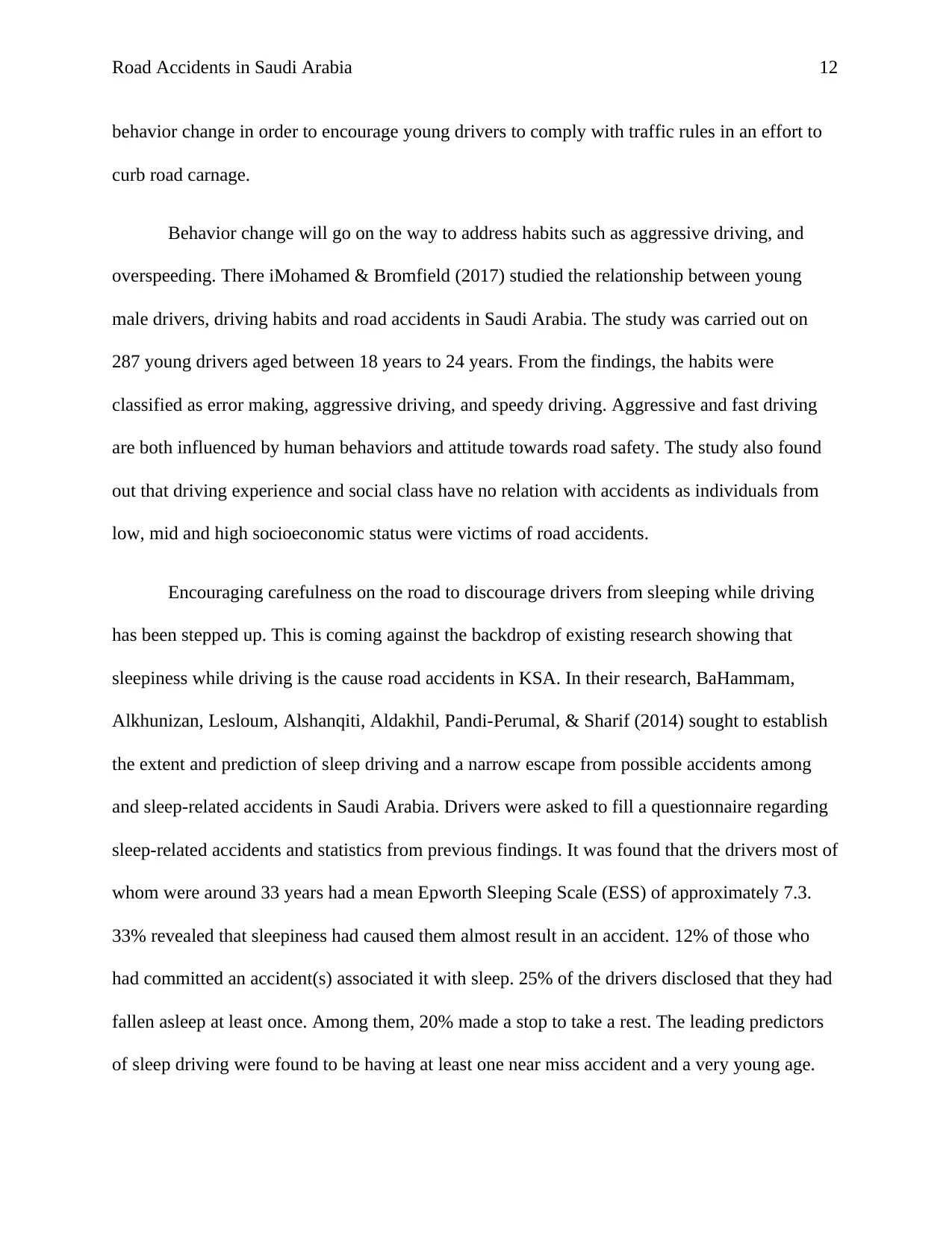
Road Accidents in Saudi Arabia 12
behavior change in order to encourage young drivers to comply with traffic rules in an effort to
curb road carnage.
Behavior change will go on the way to address habits such as aggressive driving, and
overspeeding. There iMohamed & Bromfield (2017) studied the relationship between young
male drivers, driving habits and road accidents in Saudi Arabia. The study was carried out on
287 young drivers aged between 18 years to 24 years. From the findings, the habits were
classified as error making, aggressive driving, and speedy driving. Aggressive and fast driving
are both influenced by human behaviors and attitude towards road safety. The study also found
out that driving experience and social class have no relation with accidents as individuals from
low, mid and high socioeconomic status were victims of road accidents.
Encouraging carefulness on the road to discourage drivers from sleeping while driving
has been stepped up. This is coming against the backdrop of existing research showing that
sleepiness while driving is the cause road accidents in KSA. In their research, BaHammam,
Alkhunizan, Lesloum, Alshanqiti, Aldakhil, Pandi-Perumal, & Sharif (2014) sought to establish
the extent and prediction of sleep driving and a narrow escape from possible accidents among
and sleep-related accidents in Saudi Arabia. Drivers were asked to fill a questionnaire regarding
sleep-related accidents and statistics from previous findings. It was found that the drivers most of
whom were around 33 years had a mean Epworth Sleeping Scale (ESS) of approximately 7.3.
33% revealed that sleepiness had caused them almost result in an accident. 12% of those who
had committed an accident(s) associated it with sleep. 25% of the drivers disclosed that they had
fallen asleep at least once. Among them, 20% made a stop to take a rest. The leading predictors
of sleep driving were found to be having at least one near miss accident and a very young age.
behavior change in order to encourage young drivers to comply with traffic rules in an effort to
curb road carnage.
Behavior change will go on the way to address habits such as aggressive driving, and
overspeeding. There iMohamed & Bromfield (2017) studied the relationship between young
male drivers, driving habits and road accidents in Saudi Arabia. The study was carried out on
287 young drivers aged between 18 years to 24 years. From the findings, the habits were
classified as error making, aggressive driving, and speedy driving. Aggressive and fast driving
are both influenced by human behaviors and attitude towards road safety. The study also found
out that driving experience and social class have no relation with accidents as individuals from
low, mid and high socioeconomic status were victims of road accidents.
Encouraging carefulness on the road to discourage drivers from sleeping while driving
has been stepped up. This is coming against the backdrop of existing research showing that
sleepiness while driving is the cause road accidents in KSA. In their research, BaHammam,
Alkhunizan, Lesloum, Alshanqiti, Aldakhil, Pandi-Perumal, & Sharif (2014) sought to establish
the extent and prediction of sleep driving and a narrow escape from possible accidents among
and sleep-related accidents in Saudi Arabia. Drivers were asked to fill a questionnaire regarding
sleep-related accidents and statistics from previous findings. It was found that the drivers most of
whom were around 33 years had a mean Epworth Sleeping Scale (ESS) of approximately 7.3.
33% revealed that sleepiness had caused them almost result in an accident. 12% of those who
had committed an accident(s) associated it with sleep. 25% of the drivers disclosed that they had
fallen asleep at least once. Among them, 20% made a stop to take a rest. The leading predictors
of sleep driving were found to be having at least one near miss accident and a very young age.
⊘ This is a preview!⊘
Do you want full access?
Subscribe today to unlock all pages.

Trusted by 1+ million students worldwide
1 out of 21
Your All-in-One AI-Powered Toolkit for Academic Success.
+13062052269
info@desklib.com
Available 24*7 on WhatsApp / Email
![[object Object]](/_next/static/media/star-bottom.7253800d.svg)
Unlock your academic potential
Copyright © 2020–2025 A2Z Services. All Rights Reserved. Developed and managed by ZUCOL.


